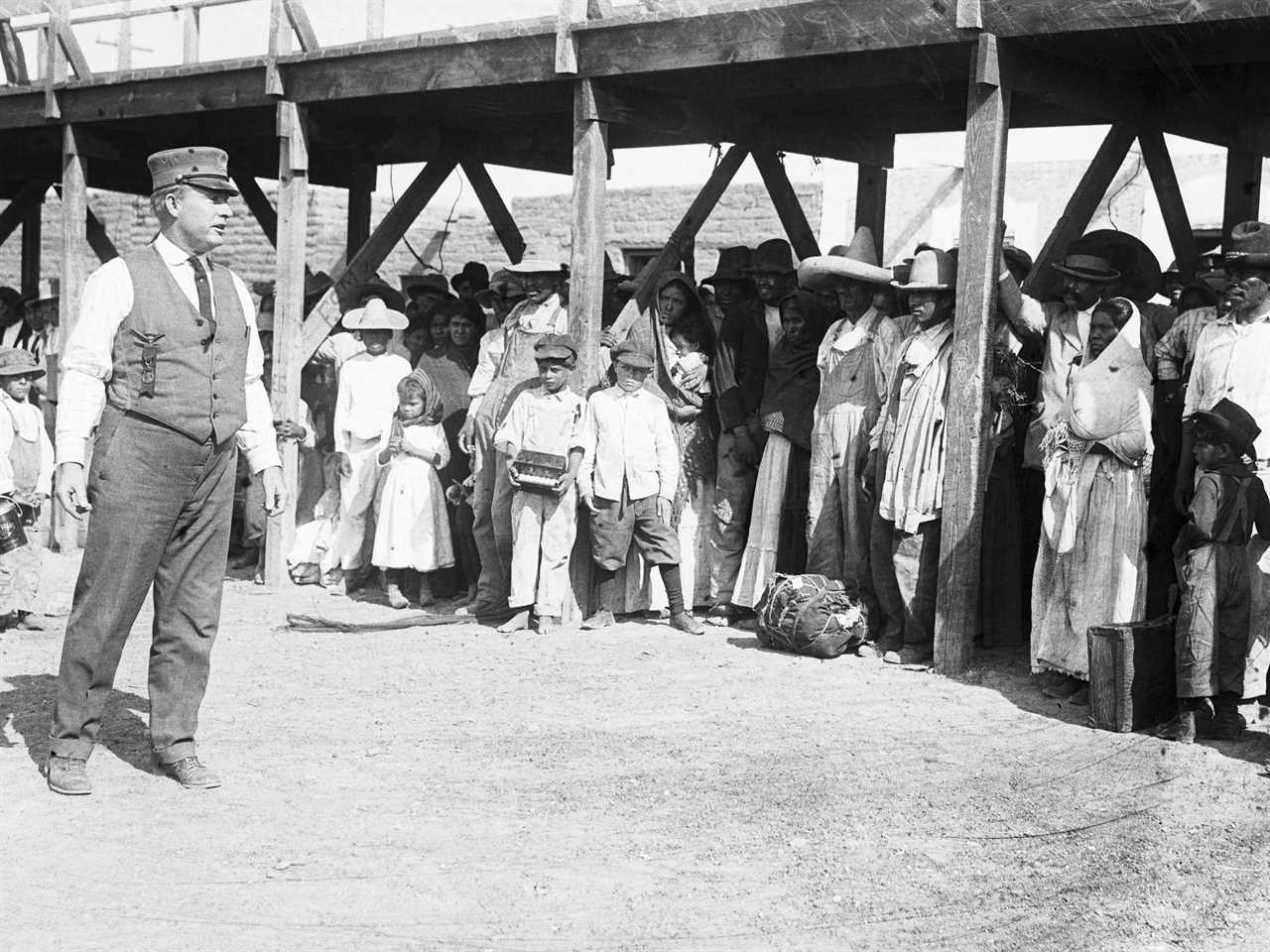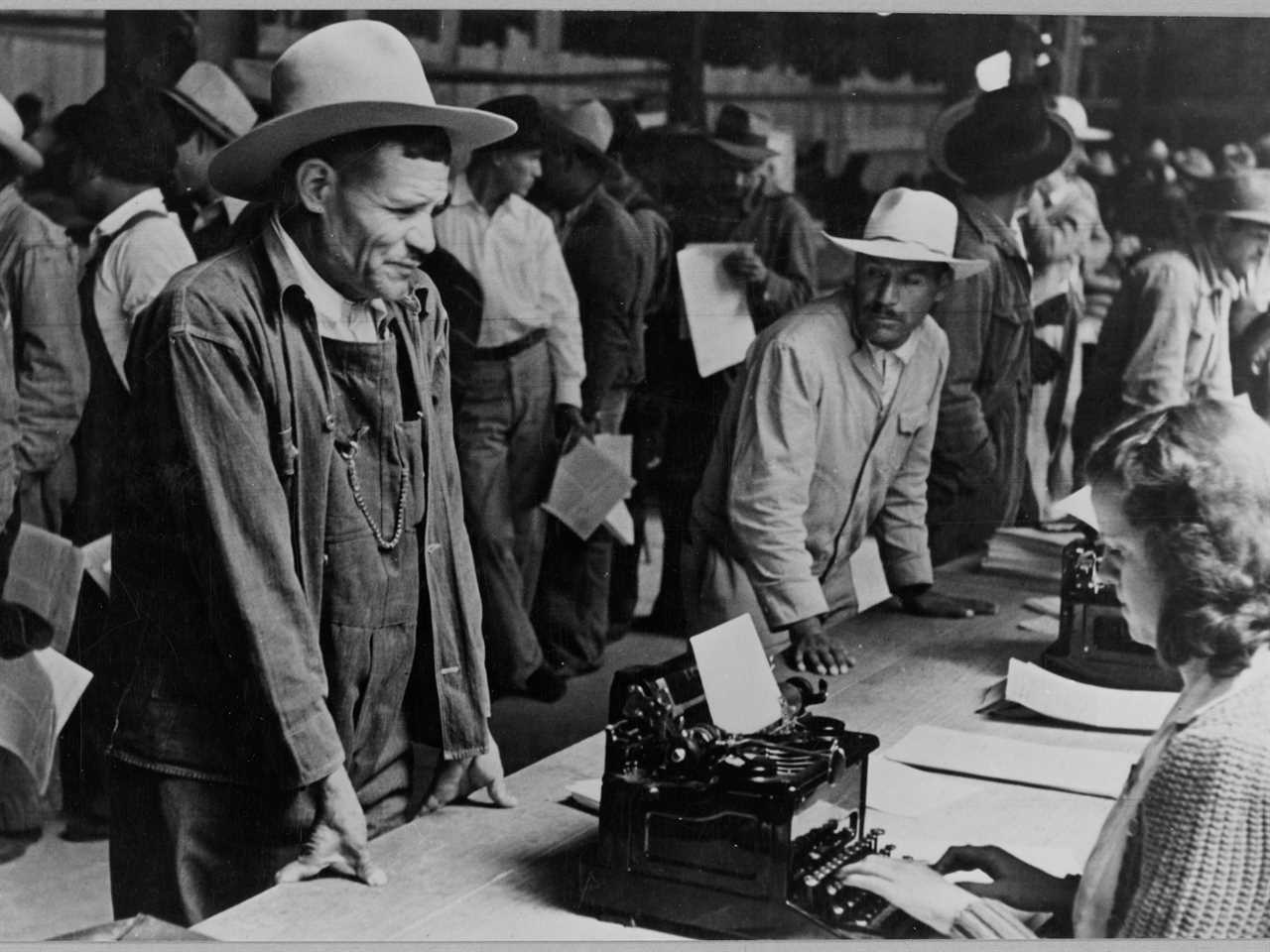Leonard Nadel Photographs and Scrapbooks, Archives Center, National Museum of American History, Smithsonian Institution
- In 1916, the US began forcing Mexicans that crossed the border to bathe in a mix of kerosene and vinegar. That later expanded to include pesticides.
- US officials feared that Mexicans could bring typhus and tuberculosis into the country.
- The Nazis used some of the same chemicals used in the baths during The Holocaust.
Until the 1920s, crossing the southern border was not heavily restricted and was not considered illegal. Domestic workers and farm laborers regularly made their way between Mexico and the United States.
But the Mexican Revolution — which began in 1910 and continued till 1917 — had seen immigration into the US dramatically increase at the border.
This provoked feelings of animosity and xenophobia among some white Americans who lived along the border, heightened by a growing culture of patriotism and paranoia due to World War I.
In El Paso, Texas — often referred to as the Ellis Island of the Southwest for being a gateway for many Mexican immigrants — tensions were particularly high.
The city's newly-elected mayor, Thomas Calloway Lea Jr. stoked racist fears of "dirty lousey destitute Mexicans" bringing typhus and other diseases into the city and, in 1916, demanded that a quarantine be put in place.
Although local Public Health Service Officer Dr. B.J. Lloyd claimed the risk of spreading disease was low and was opposed to quarantine camps, Lloyd and US officials agreed to begin setting up disinfection stations in El Paso where Mexican border-crossers would be forced to face an inspection after being stripped naked, have their possessions treated by steam, and undergo a chemical bath, which meant being sprayed down by kerosene, soap, water, and, in some cases, toxic pesticides. If a woman was suspected to have lice, her hair would also be doused in vinegar and kerosene. Those disinfection stations eventually began popping up across the length of the US-Mexico border.

Bettmann/Getty
Rumors about the disinfection process spread across Mexico. Some migrants feared that people would be burned to death in the kerosene bath, especially after at least 25 bathers died when someone lit a match in a disinfection station. Women also feared being photographed naked in the baths.
After hearing these stories, 17-year-old Carmelita Torres refused to submit to a bath. When officials would not let her proceed and would not refund her trolley fare to return, she began protesting. Other women joined Torres in her protest, eventually drawing a crowd of several thousands who gathered to watch the conflict.
The protests, now referred to as the Bath Riots, continued on for three days. Despite Torres' brave act of resistance, her legacy has mostly been lost to history.
Only a month after her protests, the US government implemented a new law that required immigrants to overcome multiple barriers before entering the country, including a literacy test, a head tax, and a passport.
The kerosene baths and the disinfection stations became a mainstay of border control throughout the 1950s, and expanded to use pesticides, including DDT.
As for Torres, police arrested her during the protests. Since her arrest, she has been missing; to this day, it is not entirely known what happened to her.

PhotoQuest/Getty Images
The racist slur 'Dirty Mexican' dates back decades
As mayor, Lea took some actions that suppressed Mexican voices. In March of 1916, Lea ordered the suspension of four Spanish-language daily newspapers published in El Paso, historian David Romo wrote in his book "Ringside Seat to a Revolution." Lea also later went on to spend a brief stint as a member of the Ku Klux Klan. (The Tom Lea Institute claims that Lea later denounced the Klan).
"He's representative of some of the powerful white people along the border," Dr. Yolanda Chavez Levya, associate professor of history at The University of Texas at El Paso, told Insider. "He didn't particularly like poor Mexicans. He was very scared that Mexican immigrants were going to bring over germs and diseases. It's a lot of the rhetoric that you still hear."
In the early 1900s, there was a fear that Mexicans crossing the border would bring over typhus. At the same time, tuberculosis was rampant across the US, killing an estimated 450 Americans per day. El Paso was considered to have the ideal dry, warm climate to combat tuberculosis, and so, multiple sanatoriums were built in the city. Levya said that while Lea encouraged Americans with tuberculosis to visit El Paso to seek treatment in the city, he stoked fear about Mexicans bringing germs and diseases.
"So it was not quite trying to bring in tourists, but trying to bring in temporary visitors, and then blaming the Mexicans for bringing the tuberculosis when it was really Americans from different parts of the US," Levya said.
In a 1916 telegram to the US Surgeon General, Lea insisted on implementing a quarantine for the "hundreds [of] dirty lousey destitute Mexicans arriving at El Paso daily." He had hoped to establish quarantine camps where Mexican border-crossers would be held for 10-14 days.
Dr. Lloyd, the local Public Service Health Officer, responded to the US Surgeon General opposing the idea of a quarantine, saying, "Typhus fever is not now and probably never will be, a serious menace to our civilian population in the United States." However, Lloyd said he would still endorse delousing stations, reiterating the same racist language Lea had previously used saying he would be willing to "bathe and disinfect all the dirty, lousy people who are coming into this country from Mexico."

Leonard Nadel Photographs and Scrapbooks, Archives Center, National Museum of American History, Smithsonian Institution
The baths targeted people based on their class and skin complexion
When the use of kerosene baths first began, men, women, and children were separated and were forced to strip naked, and their clothes were washed in large washers.
The process was humiliating for a number of reasons, Levya said. People on the US side could immediately identify bathers based on their wrinkly and damaged clothing. Some women were also reportedly photographed nude by male officers.
Levya said her mother, who came to the US in 1921, claimed that not everyone was forced to take these gasoline baths. Since Levya's mother came from a middle-class background, she was exempt.
"She said, 'We were so lucky because they knew that we were good people and they didn't make us take the baths,'" Levya said, referring to her mother. "I had never really thought about the baths in relation to her, but that really was reinforcing to me that the baths were based on class and appearance. If you were poor, if you were dark, then you were considered more potentially dangerous."

PhotoQuest/Getty Images
The 'Jail Holocaust' was a result of the kerosene baths
Throughout 1916 and 1917, the baths caused a number of catastrophes.
In 1916, dozens of inmates were killed after someone lit a match in one of the disinfecting stations. The event is now referred to as El Paso's "jail Holocaust."
As a result, Mexicans and Mexican Americans who lived along the border developed a deep fear of the baths, Levya said.
Frustration mounted, culminating with the riots led by Torres, a Mexican domestic worker, who rode the trolley across the border on a daily basis. Fellow Mexican women who were also constantly subjected to the baths as they crossed the border for work joined Torres in her resistance. As the protests grew, many rioters - including Torres - were arrested, and the US-Mexico border was shut down for several days.
"There was so much fear and anger already over that process that people joined in. Hundreds of people joined in right away," Levya said. After her arrest, Torres went missing.
One month after the protests, the US government implemented the Immigration Act of 1917. The law famously created a "barred" zone, not allowing anyone living in the zone from the Middle East to Southeast Asia to enter the US. It also excluded a number of other people, including, "idiots, imbeciles, feeble-minded persons," "prostitutes," "persons with chronic alcoholism," "persons afflicted with tuberculosis," and "contract laborers."
But as the US entered World War I, the need for contract laborers increased as Americans left the labor force to join the war effort. As such, the US government made a deal with Mexico to allow short-term laborers to cross the border and the baths continued on into the 1950s.
In total, the government is thought to have bathed 127,123 Mexicans at the bridge between Juárez and El Paso.

Bettmann / Contributor via Getty
How the baths inspired Nazi scientists
In the 1920s, the US Public Health Service began using small amounts of Zyklon B in the baths. The hydrocyanic acid was used as a fumigating agent at the El Paso disinfecting centers. A stronger version of the chemical was usually used to exterminate vermin, like mice and rats. Health officials thought it would help kill lice, which carry typhus.
Zyklon B is known to be fatal when absorbed through the skin in high concentrations. It is still unclear what lasting health impacts these baths caused on the Mexicans who had to endure them.
In 1938, a German scientist by the name of Dr. Gerhard Peters wrote an article featuring photos of El Paso's baths calling for the same tactics to be used in Nazi Germany's own disinfection chambers, known as Desinfektionskammern.
Peters became the managing director of the company that supplied Zyklon B to concentration camps, and the chemical began to be used in Nazi gas chambers beginning in 1941. He was ultimately convicted of war crimes at Nuremberg, though he was retried in 1955 and was found not guilty.
"Zyklon B was used in the baths but in very mild amounts compared to the Nazis," Levya said. "But the Nazis did learn about its use here on the border. So they were definitely studying the United States. They were looking at how laws dealt with race. They were taking a lot of cues from the United States."
Read More
By: [email protected] (DeArbea Walker)
Title: In 1916, the US began forcing Mexicans crossing the southern border to take kerosene baths. That tactic was later studied by the Nazis.
Sourced From: www.businessinsider.com/bath-riots-el-paso-mexico-texas-nazi-germany-kerosene-history-2023-10
Published Date: Thu, 09 Nov 2023 14:15:08 +0000
Did you miss our previous article...
https://trendinginbusiness.business/business/bad-bunny-rants-to-fans-over-a-viral-aigenerated-tiktok-song-that-mimicked-his-voice-you-dont-deserve-to-be-my-friends
.png)





